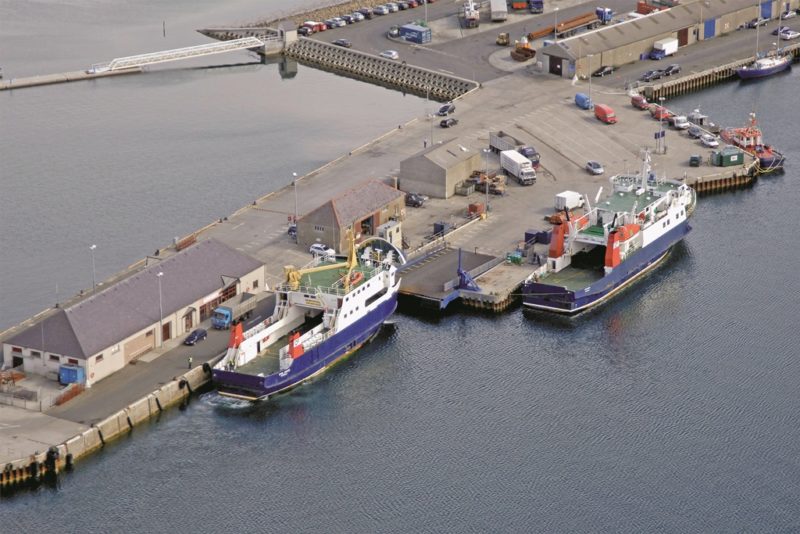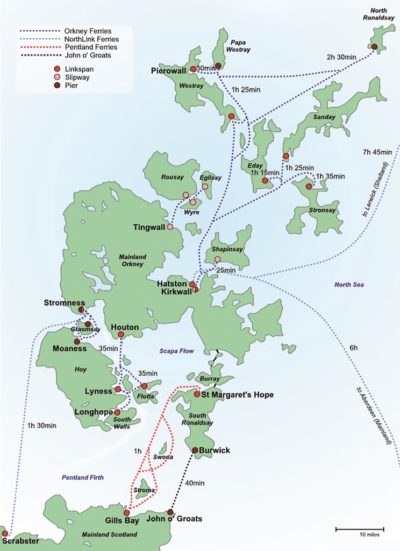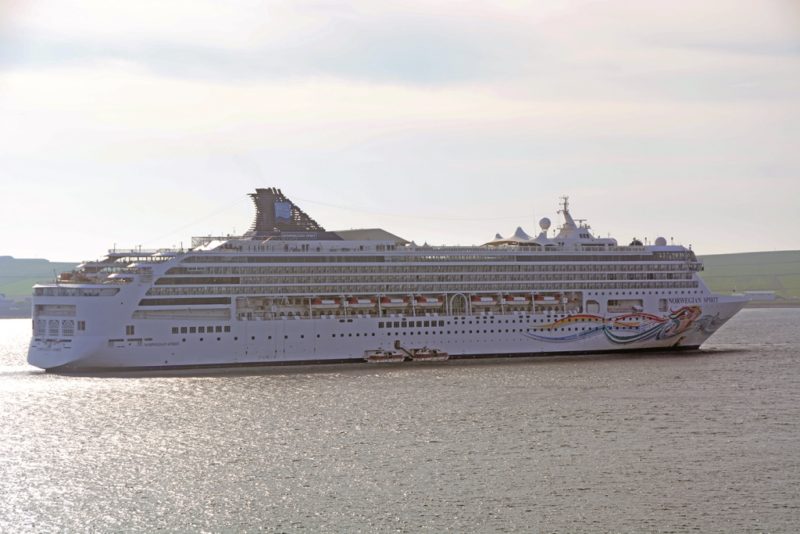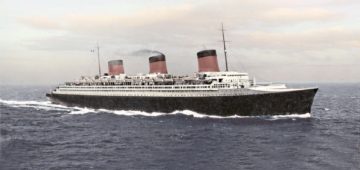
The Orkney islands are separated from the North of Scotland by the cold and often treacherous waters of the Pentland Firth, with very many ships lost in the whirlpools and tempestuous seas near Stroma and Swona islands and the rough rocks of Muckle Skerry and the Pentland Skerries. The eight man crew of the Longhope lifeboat was lost in 1969 trying to rescue the crew of a ship in difficulties off South Ronaldsay. The Orkneys are slightly closer to the Arctic Circle than to London, and number 68 islands with 29 inhabited and a small population of only 22,190. The main islands are Hoy, Mainland and bigger than all of the other islands put together, Rousay, Shapinsay, Stronsay, Westray, Eday, Sanday, South Ronaldsay and North Ronaldsay. Hoy is connected to South Walls island by a causeway which runs just to the north of the Longhope lifeboat station. Kirkwall Airport is several miles to south east of Kirkwall, with Tankerness peninsula 13 kilometres south east of Kirkwall and one kilometre east of the airport, its name derives from the Viking personal name of Tannskari.
The two towns and ports of Kirkwall and Stromness are the only communities of any size, with Kirkwall having a population of only 9,290 souls in a capital whose name is derived from the Viking name Kirkuvagr. The oldest part of the bustling harbour town of Kirkwall has narrow streets with a distinctive Viking atmosphere overlooked by the magnificent St. Magnus Cathedral, the finest of all two dozen Viking buildings or ruined settlements in the island group that have been partially or fully excavated. This is a reminder that Orkney did not become part of Scotland until the Norsemen gave it away in 1468 as a dowry. Scapa Flow is of 125 square miles in area and holds one billion cubic metres of seawater making it the second largest natural harbour in the world.


NEOLITHIC, VIKING and WARTIME HISTORY of ORKNEY
The hunter gatherers of the Neolithic period in Orkney had followed the slow retreat of the ice age glaciation, and the rapid spread of their culture up the western seaways of Scotland brought early farming and Megalithic culture. The use of the local sandstone found ready split on the foreshores of the predominantly flat islands, except for Hoy with its high ground and highest point of Ward Hill at 1,565 feet, provided the materials for this period of villages, brochs, underground chambers, chambered cairns and standing stones. The Knap of Howar on the small northern island of Papa Westray was occupied from 3,500 BC to 3,100 BC, with the word ‘Papa’ reminding us of the priests that once lived there. This is the oldest house still standing in Northern Europe, with walls intact to a low eaves height, and very useable stone furniture. At Skara Brae on Mainland, by far the biggest island in the group, passageways connect similar houses into a village dating from 3,000 BC to 2,500 BC.
The Standing Stones at Stenness, close to the exceptional Maeshowe passage grave type chambered cairn on Mainland date from the same period. The nearby Ring of Brodgar circle of standing stones was one of the first Neolithic village to be used for astronomical purposes, and another Neolithic village has been unearthed in the vicinity of Barnhouse Settlement. The early inhabitants used quern stones for the grinding of corn, tools for weaving, and simple pottery ware, and spoke a form of Gaelic. The Romans were aware of and probably circumnavigated the Orkneys, which they called Orcades, with their ruler one of the eleven tribal chiefs that paid tribute to Claudius following his invasion in 43 AD.
The Picts regained power in Scotland after the Romans left in 414 AD until disposed by the Norsemen in the 9th century. The onset of Viking raids in Northumbria in AD 793 on the Church of St. Cuthbert on Lindisfarne sent shock waves through Europe with murder, rape and pillage. These raids were earlier than when the Vikings came to the Northern islands, the lands nearest to Norway, to settle in the late 9th century as the available flat land in their homeland had been exhausted. New Viking generations chose the nearest islands of Shetland and Orkney to set up farmsteads, and one key requirement for establishing a Viking farm was proximity to a shoreline where their longships could be landed. Shetland has over 50,000 Viking place names with Orkney not far behind, incorporating words or elements such as ‘bu’, ‘bister’, ‘skail, ‘pund’ or ‘quoy’ with their farms ending with ‘ster’, ‘gard’, or ‘garth’.


Subscribe today to read the full article!
Simply click below to subscribe and not only read the full article instantly, but gain unparalleled access to the specialist magazine for shipping enthusiasts.





Comments
Sorry, comments are closed for this item